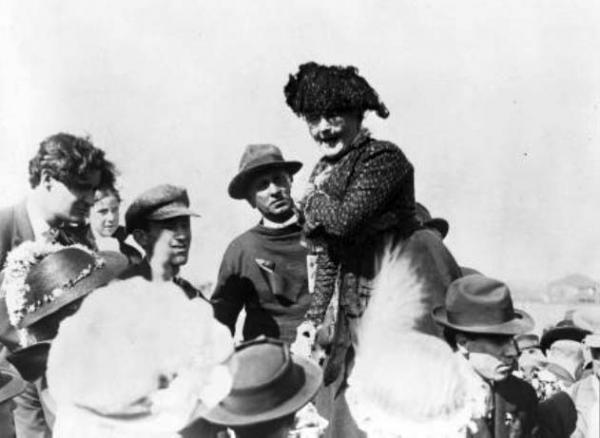March 1, 2018

Mother Jones and her adherents.
Irish-born Mary “Mother” Jones, one of America’s most famous labor activists, is the subject of a production featuring Tony nominee Maureen Brennan, with a score by Berklee College of Music faculty member Eleanor Aversa, to be presented this month at the Irish Cultural Centre of New England and at Berklee.
“Victory at Arnot” relates the story of how Mother Jones and her “pot-and-pan brigade” of women helped Pennsylvania miners in their efforts to seek safer working conditions and a living wage. Brennan provides the narrative, occasionally assuming the voice of Jones or other key figures; Aversa’s accompanying score is played by the sextet What Is Noise, whose members play flute, clarinet, piano, violin, cello, and percussion.
Aversa has received national awards such as the Northridge Composition Prize and fellowships from the MacDowell Colony, the I-Park Foundation, and the Virginia Center for the Creative Arts. Other honors include the Brian M. Israel Prize from the New York Federation of Music Clubs, as well as awards and grants from ASCAP, the Queens Council on the Arts, and the American Composers Forum. Her work has been performed in the United States and abroad, including venues such as the Boston Conservatory, the Bowdoin International Music Festival, June in Buffalo, Symphony Space, and Tanglewood.
The inspiration for “Victory at Arnot,” as Aversa describes it, is an example of free-association thinking in action: Listening to a piece she wrote for a flute choir, Aversa was struck by how much the instruments’ combined sound resembled a train whistle. “And thinking of the train somehow got me thinking of steel work, which in turn got me thinking of coal, and coal mining,” says Aversa, who joined the Berklee faculty in 2016.
This train of thought led Aversa to look at coal mining labor history, and eventually to the tale of Jones (1837-1930), a native of Cork who along with her family fled the Great Famine to Canada, and later the US. An organizer for the Knights of Labor and the United Mine Workers, she was once called “the most dangerous woman in America.” One of her most famous feats was to organize a children’s march in 1903 from Philadelphia to the New York City home of President Theodore Roosevelt, in protest of lax enforcement of child labor laws.
Jones was renowned for her passionate, earthy style of oratory, with her prominent Cork brogue. She cultivated her “Mother” image by wearing out-of-fashion black dresses and referring to the male workers she championed as her “boys.” But Jones differed from many other female activists of the era by opposing women’s suffrage, stating her belief that women’s involvement in politics resulted in a neglect of motherhood and thus contributed to juvenile delinquency.
As Aversa points, out, Jones’ activism was born of personal tragedy. “She lost her husband [labor organizer George Jones] and four children to yellow fever; and then four years after that, her home and dress shop were destroyed in the Great Chicago Fire of 1871. Most people would wither from devastating events like these, but she fought for things she could change. She helped rebuild Chicago, and then became a force for the labor movement.”
In 1899, Jones went to Arnot, Pa., to lend moral support to miners who had been on strike for several months. Hearing that the mining company was going to bring in “scabs,” Jones assembled an army of miners’ wives and other local women and told them to gather near the mine with pots, pans, mops, and brooms, and make a ruckus when the replacement workers and mine mules drew near. Jones, along with the local union president, William Wilson – later to be the first US Secretary of Labor – helped maintain the solidarity among the miners and their families, and in February 1890, the company met their demands. In the midst of a raging snowstorm, a great celebration took place.
Researching and composing “Victory at Arnot” proved to be an enlightening experience for Aversa. “Nowadays, we’ve come to take for granted things like worker’s compensation, overtime pay, and so on, but it was very, very different back in the time of Mother Jones. Reading the history, I was so inspired by her strength and determination, and that of William Wilson – that’s why I included him in the piece, too – in helping improve the lives of workers.”
Aversa says the music in “Arnot” is in the style of a film or opera score, with some themes recurring throughout, such as “an expression of the striving and energy of the miners.” As part of her research, Aversa also listened to Irish and American folk music, and incorporated some of those elements into the music, such as the victory dance at the end.
The opportunity to work with Brennan – a faculty member of the Boston Conservatory at Berklee – has been another enjoyable part of making “Victory at Arnot,” says Aversa. Brennan was nominated for a Tony Award and won a Theatre World Award for her professional debut in the 1974 revival of “Candide” on Broadway. She has also appeared on Broadway in “Going Up,” “Knickerbocker Holiday,” “Little Johnny Jones,” and “Stardust” and toured nationally as Mabel in New York Shakespeare Festival’s “The Pirates of Penzance” and has appeared off Broadway in “Shakespeare’s Cabaret.” She was nominated for Best Supporting Actress by the Independent Reviewers of New England for her performance in “Mame.”
“I was quite impressed by Maureen’s stage presence, and so I was very pleased that she liked the text of the story I sent to her,” says Aversa. “Her words will really complement the music.”
“Victory Arnot” will be presented on March 15 at 7 p.m. in Berklee College’s Oliver Colvin Hall, 1140 Boylston Street [see berklee.edu/events/victory-arnot], and on March 16, 7:30 p.m., at the Irish Cultural Centre of New England [irishculture.org].

